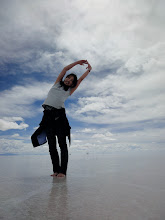skip to main |
skip to sidebar
最近CATIAやらANSYSやらの話ばかりなので、前からやってみたかったお気に入りの武勇伝コレクションを。。。
武勇伝 武勇伝 武勇でんでん ででんでん♪

怒るなよ話せばわかるよ
すごい!あっちゃん相手は犬だから!
伝言ゲームで遺言残す すごい!最後の人には意志伝わらず!
麦茶を飲んだら麺つゆだ
すごい!そのまま飲まずにそうめん茹でる!
チャンスは100パーつかみとる
すごい!ピンチで100パーダメにする!
1日3ミリバス停ずらす
すごい!2年を費やし自宅の前に!
悪口は絶対言わない
すごい!本人いるとき絶対言わない!
お墓参りは絶対に夜中
すごい! 先祖に会える確立がアップ!
頭突きでお寺の鐘を突く
すごい!煩悩以外の記憶も消える!
名古屋城を今攻め落とす
すごい!信長、秀吉、家康、あっちゃん!
川で洗濯し桃拾う
すごい!冷やしておいしくいただいた!
一円玉だけ持ち歩く
すごい!足りない分は才能で埋める!
自動改札壊し直進
すごい!そのまま駅長室直行!
423者面談
すごい!先生、両親、あと応援団!
下にいくほど、傑作だと思ったもの。武勇伝ネタは人に聞くごとにみんな好みが違ってなかなかかぶらないのが不思議です。誰かがお見事!と思ったのも他の人は、なんで?と思っていたり。
そういえばオリエンタルラジオが吹き替えしたディズニーの “ライアンを探せ” まだ観てないな。。。カメレオンのスパイコンビ役だそうです。
 Another fooling around shot with koinobori. Somehow I'm intrigued to those carp streamers. It's only once a year event in Japan when people hang koinobori. want to see hundreds of them together floating in the sky.
Another fooling around shot with koinobori. Somehow I'm intrigued to those carp streamers. It's only once a year event in Japan when people hang koinobori. want to see hundreds of them together floating in the sky.

New Terminology
Goal_
Structural optimization runs for the purpose of achieving a Goal. ANSYS takes CATIA parameters, goes over every single one of them, and negotiate between them to achieve a Goal. Even in the case where multiple results are available, ANSYS stops the optimization as soon as it arranges the first available set of parameters. The software doesn't consider what parameter to calculate first, unless user assigns priority to parameters.
Boundary_
User can set Boundary for each parameter for the purpose of not losing the original form, or of considering the available material size. If the prior parameter reaches the boundary, and yet the Goal is not satisfied, ANSYS starts negotiating secondary parameters. Therefore, there are some cases where ANSYS doesn't give any answer. In those cases, user needs to reconsider the Goal, or give Boundaries more flexibility.
Stochastic Analysis_
Field of mathematics dealing with a process involving a randomly determined sequence of observations each of which is considered as a sample of one element from a probability distribution. also deals with Numerical Analysis. ANSYS employs Stochastic Analysis to go over and negotiate between multiple parameters to achieve a Goal within each prioritized Boundary.
The Great Gatsby の冒頭文に関する考察、または連想ゲーム。
In my younger and more vulnerable years my father gave me some advice that I've been turning over in my mind ever since. 'Whenever you feel like criticizing anyone,' he told me, 'just remember that all the people in this world haven't had the advantages that you've had.'
LAの青空はいつも白々しい。ちょっと留守にしただけで “よ~こそLAへっ!” って顔をして澄ましている。帰ってくる人を迎える気というものが全く感じられない。
何でこんなにたくさんの人種というより人間がいて、誰にとっても自分の家族友人恋人以外の人間はカンケーないんだろう。そんな人間どもがひしめき合って都市が、国が、機能するんだろう。どんなに夢があったとて、大切にしたいと思える人なしにどうやって人生を豊かにせよというのか。
留学5年目にして、人間が死ぬまでにすべきことなんて、イイ女、イイ男になって精一杯手の届く範囲の人々を幸せにすることだけだと実感してしまったらどうしたらいいですか?ついでにその時までにはその程度には大切に想えるボーイフレンドがいたり、私の競争心まるだしの心を何度でもすっと抑えてくれる友たちに囲まれていたり、ゼロから始め少しずつできるようになり、やりがいを感じる仕事が選べるようになっていたりするんです。御丁寧に。
卒業後スグ働ける建築のように、渡米してキョロキョロせずにゼロからのキャリアをさっさと歩き始めた自分にびっくりしたけど大変心強く思うし、他の留学生に対して口にすれば殴られそうなことを考えてもいましたし、実際に呆れるくらい高慢だったからこそ stay away できたこともあるし。両親からの仕送りで生活していて “よい経験” だなんておアソビで本当に申し訳ない。
幼い頃より愛情をいっぱい頂きましたので危なっかしいことを危なっかしくなくこなしていく自分に自信がありますが、悪さして調子にのる程気が大きくはなかったのに門限とか厳しい環境にいたことで、今だに世界を呑んでかかることができません。これを克服するのに残りの一生を費やすとしても私は家族を愛しているので平気です。
私もあと13年くらいしたらSky と子供を育ててみたい。彼に似て思いっきり生意気で、でも私みたいにコツコツとやっていける、いつ手放しても惜しくない、どこに出しても恥ずかしくない男の子を。私くらい度胸があって、Sky くらい人の心がわかる実力のある女の子を。

卒業に必要な物理、数学を終えて以来久しぶりの三角関数 :P
ケーススタディーとして丹下健三の代々木アリーナを数学的に分析し、建築家の仕組んだ暗号を解読。そして数式を組み替え別バージョンを作ってみる、という課題。くわばらくわばら。三木先生ありがとう。

CATIA case study. Harder than I expected...
I thought I was pretty good at planing modeling history, but the red means the geometry (relationship) is failing.
SCI-ARC hosted a conversation lecture about Dragonfly on 6/13.
Dragonflyに携わった Architect と Structure Engineer によるレクチャー。

Stephen (Engineer):
We used RISA, and ANSYS for optimization of this cantilever. We didn't get rid of every inches in the end, but we did pretty good job.
Eric Owen Moss :
If you were to optimize, you were not gonna build it, c'mon...

Tom (Architect):
I designed this tip to be 36 inches higher... I can reach it now.
Matthew (Engineer):
Well, everybody seems pretty comfortable hanging out underneath it.
 Following the previous post regarding thesis, this is the Floral St. Bridge CATIA model. Lionel's tutorial had more variety in form. I changed parameters so that-both ends of the bridge don't change in size or location.-square frames don't change in size or shape.I want to use Floral St. Bridge as an example of CATIA usage in aesthetics. In this case, the bridge was constructed off site and just dropped in place. Structure is strong enough to support 23 frames over 34' span. Only variety allowed was the overall shape (rotation of frames within xz plane and curvature of spline that connects one entrance to the other).
Following the previous post regarding thesis, this is the Floral St. Bridge CATIA model. Lionel's tutorial had more variety in form. I changed parameters so that-both ends of the bridge don't change in size or location.-square frames don't change in size or shape.I want to use Floral St. Bridge as an example of CATIA usage in aesthetics. In this case, the bridge was constructed off site and just dropped in place. Structure is strong enough to support 23 frames over 34' span. Only variety allowed was the overall shape (rotation of frames within xz plane and curvature of spline that connects one entrance to the other).















